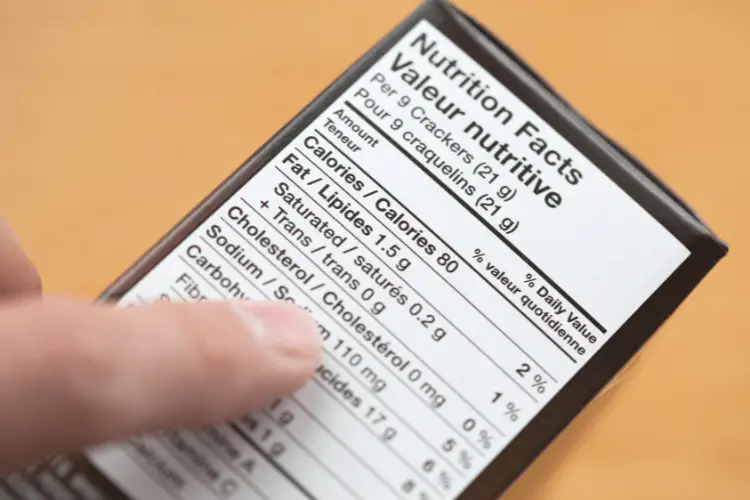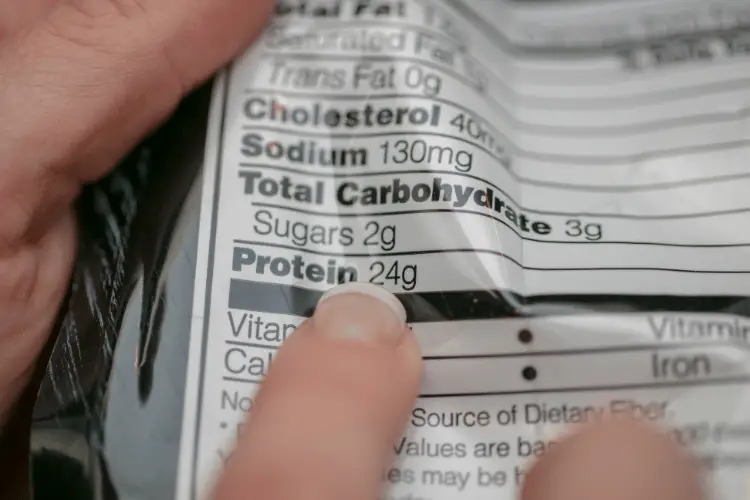Think back to the last time you were shopping for food. Can you still remember the last time you checked the nutritional labels pasted behind the packaging of food products?
If not, you’re not alone. For most people, reading the nutrition labels of food products is a tricky business that seemingly needs extensive research to comprehend.
There are several reasons why food labels are baffling to many. The odd concepts, complicated layouts, and unfamiliar names of some ingredients make it difficult to comprehend.
That said, being able to read the food descriptions is a great shopping skill to have. So stick with us, and let’s discuss why are nutrition labels so hard to read.
Brief History of Nutrition Labels
Food labeling began as a precautionary measure against foodborne diseases in the 1850s. Back then, the USDA was the agency to enforce food regulatory guidelines and protocols.
In the 1960s, consumers swerved their attention toward processed and packaged foods. This trend led to the demand for comprehensive food production information.
A few years later, the USDA ordered that all products sold between the states must include a list of ingredients. This mandate became the precursor for nutrition-related labeling.
However, in 1973, concerns about misleading labels emerged. The issue forced the US Supreme Court to mandate nutritional facts on products with health claims.
Finally, in the 1990s, US President George H. W. signed the Nutrition Labeling and Education Act (NLEA). Through this bill, the FDA demanded food manufacturers include a detailed ingredient list, reliable health claims, and standardized nutrition facts on all their products.
Food Product Nutrition Labels
The nutrition information on consumable products is a means to encourage consumers to make healthier food choices. The FDA requires every food product to have it on its packaging.
These labels typically contain a breakdown of nutritional content—the calories, carbs, fat, fiber, and vitamins per serving. These details make it easier to compare with other similar products.
However, as helpful as these labels are, research has shown that a large portion of the population finds them challenging to read.
A particular study on food label awareness revealed that more than half of consumers (57%) don’t understand nutrition details, while others (39%) claim to only “partially” comprehend.
The same research found that only a tiny percentage (9%) of buyers use nutritional information and that most consumers never relied on labels for their food choice.
While shoppers typically check the nutritional details, they don’t necessarily understand what they’re reading. For this reason, food labels remain mostly underutilized or unused.
Nutrition Labels Use Uncommon Terms
The terminologies used in these labels are one of the reasons why most people have difficulty reading nutritional labels. They feature concepts we don’t commonly use every day.
To understand the meaning of the words, you need to be familiar with nutritional science and chemistry terms. Concepts like Percent Daily Value and Serving Details can be confusing.
Some descriptions of primary ingredients also fail to convey their meaning effectively. This issue makes understanding their significance difficult.
For instance, you might find the words “saturated” or “unsaturated fat” in the food packaging. It refers to the chemical makeup of fatty acids in consumable products. Less than 1% of people that I’ve personally surveyed actually understand that.
In this case, a diagram would be helpful for someone who doesn’t know the difference between those two. However, as you may already know, graphs aren’t standard on product labels.
Complicated Layout

Another issue that makes reading nutritional labels difficult is the complicated layout. Some arrangements don’t consider customer knowledge and aren’t user-friendly.
For example, in most consumable label designs, you can locate the information on the sugar enclosed under carbohydrates. This setup is problematic as most shoppers don’t know that the carbohydrate count includes the sugar content.
Besides, the term carbohydrate is imprecise in the first place. Although we commonly categorize carbs together with sugar, they contain other components like starch and fiber.
Furthermore, the font size used in nutritional labels is also an issue for some buyers. While the FDA established font specifications, this guideline seems ineffective for older shoppers.
A study on the readability of nutritional labels in 2011 revealed this issue. The researchers discovered that most respondents aged 60 and above found reading labels challenging.
Understanding the Components of Food Labels
The Food and Drug Administration (FDA) is responsible for the safety of the products Americans consume. They also ensure that all consumable products are correctly labeled.
That said, the bureau drafted a guideline on the format and contents of food product descriptions. Here are the four primary components of nutritional labels according to the FDA:
1. Serving Information
You can usually find the serving size information on the upper portion of nutrition labels. Manufacturers typically bold this heading using a larger font.
The information under this heading refers to the number of servings and serving sizes of a particular food. For easy reference, most brands use a standardized unit of measurement.
In the US, the serving information in food products typically utilizes customary units like cups or pieces. Then, the following values are the metric units of each serving, such as grams.
One thing to remember is that all information within the label refers to the serving description. It means each serving size contains all the nutrient values outlined on the nutritional label.
2. Calories
The label also lists the calorie amount of each food serving. Like the serving size description, the calorie amount is bolded and in larger fonts.
Calorie intake is crucial for health-conscious individuals or those trying to lose weight. So, be sure to note the serving size to avoid doubling the number of calories you consume.
To illustrate, if a food snack says 100 calories per serving, you might wrongly assume that the bag contains one serving. However, each snack bag actually holds two or three servings.
So, if you consume the whole bag of snacks, you’re taking in double or triple the calorie amount mentioned on the label. That’s two to three miles more mileage for you!
3. Nutrients
The third section of food labels typically involves nutritional data on consumable products. It outlines the vital nutrients that can affect your overall health.
You can find the total fat, trans fat, saturated fat, sodium, cholesterol, total sugar, added sugar, total carbohydrates, fibers, protein, and minerals in this label’s portion.
You can use the information in the nutrient section for your personal dietary needs. It’s a practical tool for individuals with medical conditions to regulate their food intake.
For example, people with existing cardiovascular diseases or high blood pressure must be wary of a food product’s fat and sodium content. On the other hand, individuals who are trying to lose weight should watch the added sugar information.

4. Percent Daily Value
The %Daily Value depicts how much nutrients each serving of a particular food contributes to your daily nutritional needs (DV). Your DV, however, may vary depending on your age and sex.
That said, you can use the %DV as a reference when measuring how much a food product affects your diet. Simply put, it tells you how much nutrients you’re receiving in each serving without having to manually calculate it!
Guidelines for Using the Percent Daily Value
The %DV is a reliable reference point when comparing consumable products. Here are some facts to remember when using the percent daily value:
- 5% DV or less of a nutrient per serving is considered low. Aim for this %DV if you’re following a strict diet to improve your cardiovascular health.
- 10% to 19% DV means the product is a good source of a particular nutrient. Aim for this %DV for a balanced nutritional consumption.
- 20% DV or more of a nutrient per serving is considered high. Aim for this %DV if you’re trying to consume more of a specific nutrient.
- Choose foods containing a higher %DV of Iron, Potassium, Calcium, Vitamin D, and Dietary fiber.
- Choose foods containing a lower %DV of Saturated Fat, Added Sugars, and Sodium.
- Try to use the %DV when comparing food products. For instance, you can compare consumables in terms of added sugar and pick the ones with a lower %DV.
The %DV isn’t as accurate as the Recommended Dietary Allowances (RDA). While it’s useful for quick comparisons, refer to your RDA for a more precise calculation.
Nutritional Label Formats
As much as the contents, the FDA also regulates the format of food labels. They do this in an effort to make for easy reading and identifying specific information.
1. Vertical Display
The most common format is the vertical display with the nutrients listed side by side. In this variation, you can find the %DV and other units of measurement listed on the right side portion.
2. Tabular Display
The tabular orientation is designed for small to medium-sized food brands. It’s a long rectangular shape typically found at the lower back of the packaging.
3. Dual Column Display
A dual-column display is typical on products with more than one serving but can be consumed quickly. It separates the calculation of nutrients in a single serving and the whole package.
4. Linear Display
A linear display is closely similar to the tabular format. However, it contains fewer text bolds, and they confine the information closely inside a small rectangular strip.
5. Single-Ingredient Sugar Labels
Unlike most food, the FDA doesn’t require maple syrup, honey, and anything involving pure sugar to declare their added sugar content. These cases use single-ingredient sugar labels.

Tips for Reading Food Labels
According to SNWS, 53% of Americans distrust nutritional labels because they believe they’re misleading. This news isn’t surprising, given the notorious difficulty in comprehending them.
Are you one of those who feels like these labels are deceiving you? Here are some effective tricks to add up your sleeve when reading food labels:
1. Ignore Front Labels
The golden rule when purchasing packaged food is to be cautious of the information on the front labels. Most often than not, they present compelling words as an advertising strategy.
Simply put, the front labels are there to lure buyers with attractive words, such as “light” or “organic.” Read the ingredients carefully, and don’t be misled by these marketing messages.
2. Note the Ingredients
The FDA enforces a transparent declaration of ingredients in food products. To this end, they require manufacturers to list ingredients in descending order.
You can use this information to your advantage as a buyer. Identify the top three ingredients in the packaging and avoid those that contain refined grains or hydrogenated oils.
3. Learn the Sugary Terms
If you’re conscious of your sugar intake, you must know the different names glucose takes on labels. Food manufacturers sometimes break down different types of sugar, which is misleading.
Some of these sugary terms may be hard to spot or recognize. If you find words like corn sweetener, maltose, dextran, and malt syrup, these are simply other names for sugar.
Final Thoughts
For many shoppers, the nutritional description of products is a good source of information about the food they consume. For this reason, it’s crucial that they’re readable and trustworthy.
That said, the FDA has taken significant steps to ensure that nutrition labels are comprehensible to consumers. So make the most out of these labels and use them in your next shopping!
References
- https://ucfoodsafety.ucdavis.edu/processing-distribution/regulations-processing-food/food-labeling
- https://www.ncbi.nlm.nih.gov/pmc/articles/PMC5903167/
- https://www.fda.gov/food/new-nutrition-facts-label/lows-and-highs-percent-daily-value-new-nutrition-facts-label
- https://familydoctor.org/nutrition-how-to-read-a-nutrition-facts-label/
- https://byjus.com/biology/difference-between-saturated-and-unsaturated-fats/
- https://www.grin.com/document/284516
- https://www.gmp-compliance.org/gmp-news/fdas-recommended-font-and-font-size-for-instructions-for-use-labeling
- https://onlinelibrary.wiley.com/doi/pdf/10.1002/pdi.1611
- https://www.usa.gov/federal-agencies/food-and-drug-administration
- https://www.fda.gov/files/food/published/Food-Labeling-Guide
- https://www.fda.gov/media/133699/download
- https://www.acefitness.org/about-ace/press-room/in-the-news/8248/how-many-calories-do-you-burn-running-a-mile-healthline/
- https://www.cdc.gov/heartdisease/sodium.htm
- https://www.webmd.com/diet/ss/slideshow-effects-cut-added-sugar
- https://ods.od.nih.gov/HealthInformation/dailyvalues.aspx
- https://www.ncbi.nlm.nih.gov/books/NBK234926/
- https://www.fda.gov/media/99151/download
- https://swnsdigital.com/us/2018/06/americans-dont-trust-food-labels-study-finds/
- https://www.hsph.harvard.edu/nutritionsource/food-label-guide/
- https://www.fda.gov/food/food-ingredients-packaging/overview-food-ingredients-additives-colors#qalabel
- https://www.healthline.com/nutrition/why-refined-carbs-are-bad
- https://www.healthline.com/nutrition/56-different-names-for-sugar
- https://he.utexas.edu/ntr-news-list/food-labels-history
- https://www.congress.gov/bill/101st-congress/house-bill/3562



